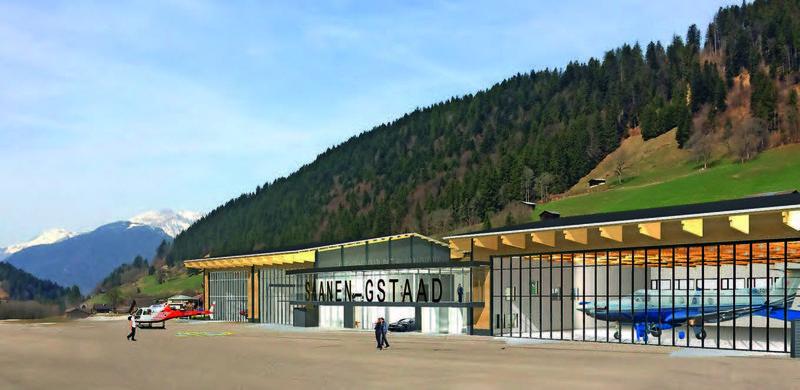Perfect Landing -- Gstaad-Saanenland Airport Gets a Much-Needed Makeover
01.07.2015 Lifestyle
The remaking of the only airport in the Saanenland is not up for debate–the airport must be renovated to ensure optimal safety. Residents will say goodbye to decrepit facilities and dated infrastructure of the original airfield, which and was built by the military during World War II for defense purposes in the early 1940s. In 1986, the runway was rehabilitated; in June 2011 the airfield was bought by the FGGS (Airfield Cooperative Gstaad-Saanenland). The FGGS is responsible for bringing this current project to life.
Designed to Fly
Architect Elisabeth Wampfler of local firm Jaggi & Partner led the total redesign, which features several important upgrades. “The building faces south so we can use solar energy for some of the airfield’s light, heat and electrical needs,” says Wampfler. An attention to safety also marks this design.
“The infrastructure for air operations will be concentrated on the north side,” says FGGS President Walter Egger, explaining that currently, some workers have to cross the runway to exit the airfield. “This will reduce the dangerous runway crossings.”
In addition to repaving the runway, a grand, new structure will be built to host airfield’s terminal and hangars. To the left of the terminal, two hangars for helicopters will be used by Air Glaciers and the handful of businessmen who commute this way to Geneva each day. To the right, three hangers for aircraft will feature rotating storage units, allowing for pilots to park airplanes on their own without additional help.
The terminal building will consist of two floors and a large observation deck. In addition to a customs declaration area and waiting room, management offices will be located on the ground floor. Air traffic control will occupy the next level. Visitors will be able to access the observation deck, built on the structure’s flat roof.
Great care has been taken to design structures which respect the airfield’s natural location. The project’s supervisors say it will be easy on the eyes and fit in nicely with the surrounding landscape.
Blue Skies Ahead
Naysayers don’t have much to fret about–the renovation is not expected to increase air traffic. Only 8200 flights are permitted per year, a number designated by the Swiss Federal Office of Civil Aviation, which oversees such quotas.
“The flight total estimate is 6560,” says Egger, “which is well within the legal limit.”
The High Price of Modern Aviation
Despite the benefits of renewing the aiport’s infrastructure, it doesn’t come cheap. The price tag: total of CHF 30 million. Two-thirds of the cost will come from private donors, while the remaining CHF 10 million has been pledged by the municipality of Saanen.
The search for potential donors is currently underway. FGG Boardmember Marcel Bach says he has several verbal promises and hopes to have signed letters of intent by the end of the year. Bach says that once funded, the project will be self-supporting.
Heinz Brand, Saanen Councilman, confirms the CHF 10 million contribution to come from Saanen, but admits public institutions like the other municipalities and cantons should contribute as well.
“The Saanenland lives from tourism,” says Egger, when asked about the need for such infrastructure. “The airport is vital for this reason.”
As a destination for upscale visitors and wealthy part-time residents, Saanen needs an airfield which can handle the influx of private planes.
Gstaad Saanenland Tourism supports the project wholeheartedly, Director Martin Bachofner told the group of 80 attendees at an information seminar in May.
“Tourism in Switzerland faces enormous challenges," says Bachofner. “Switzerland has always been a high-priced country…to remain competitive internationally it must invest in power and infrastructure.”
Time to Fly
The FGGS group has an ambitious timeframe–the building application will be filed in June, and the financing is expected to be secured by next year. The project will go before the Swiss Federal Office of Civil Aviation, which is charged with either approving or rejecting it. According to Egger, if everything goes smoothly, construction will begin in 2016 and the entire project will be completed by 2018.




